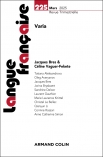
Romantisme n° 156 (2/2012)
Pour acheter ce numéro, contactez-nous
Recevez les numéros de l'année en cours et accédez à l'intégralité des articles en ligne.
Peut-on concevoir Uspud, ballet chrétien, d’Érik Satie, comme une mystification ? Non, dans la mesure où Satie ne voulut ni ne réussit à mystifier personne lorsqu’il chercha à faire représenter Uspud à l’Opéra de Paris. Il était clair pour tous qu’Uspud était comique, grotesque, inadapté, ridicule, caricatural – bref, une mystification ; et une mystification qui s’affiche comme telle n’en est sans doute pas une. Mais Satie réussit parfaitement à mystifier les hommes qui dirigeaient les institutions musicales de l’époque, dans la mesure où ceux-ci ne virent pas qu’un chef-d’oeuvre révolutionnaire leur passait sous le nez. Leur incompréhension devait être, pour Satie, un gage de la valeur de son ballet ; car toute oeuvre vraiment neuve doit paraître mystificatrice aux yeux des hommes en place.
Is it possible to understand Erik Satie’s Uspud, ballet chrétien as a mystification ? No, given that Satie neither wanted nor managed to mystify anyone when he tried to get Uspud performed at the Paris Opera. It was clear to all that Uspud was comical, grotesque, inadequate, ridiculous, and caricatural – in other words, a mystification ; but a mystification that publicises itself as such is a failed mystification, it would seem. However Satie succeeded perfectly in mystifying the men who were leading the main musical institutions of the time, inasmuch as these never saw they were letting a revolutionary masterpiece disappear from underneath their noses. Their lack of understanding had to be, for Satie, a measure of the value of his ballet ; for any really innovative work must pass for a mystification in the eyes of the powers that be.

